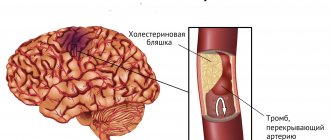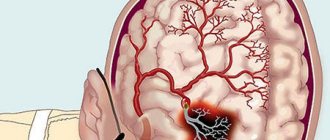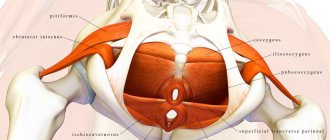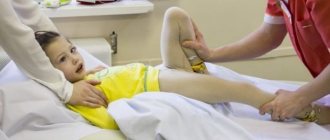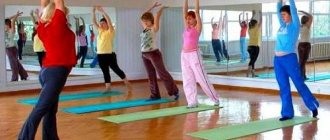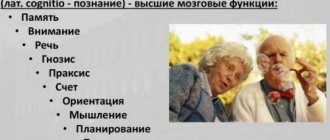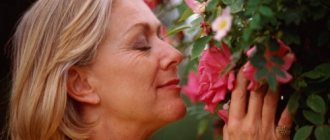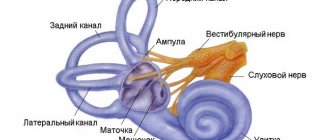Speech therapy massage is regulated. I session – 20–25 minutes. (5 minutes of relaxation, 10–15 minutes of acupressure and/or segmental massage, and then 5 minutes of articulation gymnastics) an approximate complex of acupressure massage is given (see table No. 4).
Table No. 4. Approximate acupressure complex for one course
20–30 minutes after the complex session, it is recommended to conduct a speech therapy session on sound formation.
In the book by E.A. Dyakova “Speech Therapy Massage”, 2003, all the techniques of speech therapy massage are well illustrated (photos are given). Methodological recommendations for conducting a relaxing and strengthening massage are indicated. In addition, various complexes of acupressure at biologically active points (BAP) are presented.
9 acupressure complexes are presented, the purpose of which is to normalize various functions:
Complex BAT 1 . Goal: normalization of mouse articulatory muscles. Impact on points: 35, (see below figure No. 10, 11 points of local action) 32, 30, 33, 17.
Complex BAT 2 . Goal: improvement of nasal breathing, prevention of voice disorders. Impact on points: 39, 16, 15, 35.
Complex BAT 3 . Goal: normalization of the tone of the vocal apparatus. Impact on points: 28, 29.
Complex BAT 4 . Goal: normalization of muscle tone of the root of the tongue and larynx. Impact on points: 29, 22.
Rice. 10. Local action points.
Complex BAT 5 . Goal: normalization of muscle tone of the lower jaw. Impact on points: 34, 20, 36.
Complex BAT 6 . Goal: normalization of the neck muscles. Impact on points: 23, 24, 25, 26.
Rice. 11. Local action points.
Rice. 12.
Complex BAT 7 . Goal: normalization of breathing rhythm. Impact of Hsa points: A, B, C (Fig. 12).
Complex BAT 8 . Purpose: relieving tension from the muscles of the vocal apparatus. Impact on points: A – on the legs, B – on the arms (Fig. 13, 14).
Rice. 13.
Rice. 14.
Complex BAT 9 . Goal: activation of the body as a whole. Impact on point 31 (see points of local action) (Fig. 10).
Here is a fig. 15, representing the topography of points on the head. The names of the points are given in Russian transcription.
Rice. 15. Topography of points on the head.
Wai-jin-jin, Wai-yu-e.
Deserves special attention in the book by E.A. Dyakova (2003) section of self-massage, which involves the child performing independent massage actions.
In our opinion, for children with dysarthria, self-massage of the facial and labial muscles can and should be recommended after significant preparatory work on the development of fine motor skills of the hands, on the development of stereognosis and spatial concepts, including the ability to navigate the diagram of one’s own body. Self-massage of the tongue is necessary during articulation gymnastics.
For children with congenital pathology of the maxillofacial region, recommendations for myo-gymnastics and massage have been developed (Ponomareva E.A., Sokolova L.A. 1997). techniques of speech therapy massage in the post-operative period in connection with uranoplasty are described in detail in the works of Ermakova I.I. (1984), Ippolitova A.G. (1983), Vazovskaya L.I. (1984).
Speech therapy massage in a complex of measures aimed at eliminating stuttering is described in the works of Shevtsova E.E. (1994, 2003), etc.
Who treats dysarthria
To correct the situation, you need to contact two specialists - a neurologist and a speech pathologist. An accurate assessment of the condition can only be determined after a thorough examination and history taking.
Corrective measures are also carried out in two directions - neurological and speech therapy. An integrated approach includes methods such as:
- Drug therapy.
- Physiotherapy.
- Physiotherapy.
- Speech therapy classes.
Characteristics of the pathology
Dysarthria occurs in different types, for example, bulbar, subcortical, cerebellar, pseudobulbar and cortical. The specific type depends on the location of the lesion that caused the speech disorder.
There are many factors that lead to the development of the disease. It is important for the patient to become familiar with them so that they can normalize their well-being. When treating, it is imperative to deal with the root cause that caused the deviations.
Provoking factors:
- Traumatic brain injuries. Because of them, speech function disorders are often observed. Moreover, this cause is predominantly found in children and young people.
- Neoplasms in the brain. Because of them, compression of the organ occurs, which leads to a general deterioration in health. In such a situation, it is imperative to deal with the root cause, and treatment methods are determined depending on the location of the tumor and its nature.
- Stroke. It causes an acute circulatory disorder. It can occur due to a blood clot blocking the vessels, as well as due to cerebral hemorrhage. In any case, most patients report speech impairment.
- Birth injuries. Some children develop dysarthria due to problems associated with birth. In such a situation, the first symptoms of pathology become noticeable within the first year of life.
- Severe toxicosis in early pregnancy, prolonged or rapid labor. Dysarthria is also often diagnosed in premature babies. It is caused by hypoxia that occurs during intrauterine development. It is because of problematic pregnancy that speech function is often impaired in children.
There are many other reasons that lead to the occurrence of the disease. It is equally important to know the symptoms of pathology so that you can identify it in time. A person should not wait until their health worsens significantly. If you consult a doctor in a timely manner, you will have a much better chance of normalizing speech function.
The work of a speech therapist-defectologist for dysarthria
In this case, the speech pathologist-defectologist takes on the responsible role of correcting existing disorders in the child’s speech. It is very important that parents understand the need for regular classes and mandatory homework.
With the right approach, the prognosis for the erased form of dysarthria is the most favorable. The child is fully capable of mastering correct speech and will be able to successfully study at school.
What is included in the classes:
- Articulation gymnastics. It is necessary in order to “teach” the tongue to take the correct place when pronouncing a particular sound.
- Exercises to develop correct speech breathing.
- Development of fine motor skills. It is widely known that the better the coordination of the fingers, the faster correct speech is formed.
- Formation of spatial orientation.
- Speech therapy tongue massage. Even due to minor brain damage, many children have disturbances in the tone of the articulatory apparatus. A special massage helps relieve excess tone or, conversely, strengthen the necessary muscles.
- Establishing the correct pronunciation of sounds.
Indications and contraindications for tongue massage
Relaxing the muscles of the neck and shoulder girdle
- We stroke the neck with both hands, moving from top to bottom.
- We rotate the child's head clockwise and counterclockwise, holding the back of the neck with one hand, and placing the other hand on the fronto-parietal part.
- We tilt the child's head back and forth, left and right.
Relaxing facial muscles
- At the same time, use the fingertips of both hands to make stroking movements 7-10 times:
- to the temples from the center of the forehead;
- to eyebrow hair;
- around the eyes in different directions;
- to the temples from the bridge of the nose, running your fingers under the lower eyelids;
- to the ears from the corners of the lips;
- on the forehead, cheeks, chin and neck;
- to the earlobes from the wings of the nose.
- Lightly pinch the edges of the lower jaw;
- We press with the pads of all fingers on the face from the roots of the hair to the chin.
Relaxing the lip muscles
- With your mouth closed or slightly open, stroke the upper and lower lips from the corners to the middle, and trace the lips with your fingers.
- We pass along the nasolabial folds from top to bottom.
- Tap the area around the lips clockwise.
Relaxing the muscles of the tongue
- To relax the root of the tongue, first perform the following exercises:
- massage the extreme points of the lower jaw;
- massage the submandibular fossa;
- move the tongue to the right and left, then forward and backward, grabbing its tip with your hand.
- With our left hand we hold the tongue outside the mouth through a gauze napkin or a clean handkerchief, with our right hand we perform massage movements with our fingers in pharmaceutical rubber gloves, a soft toothbrush or special massage speech therapy probes:
- We perform relaxing stroking movements from the tip to the root of the tongue along, across, on the sides, in circles;
- pat the tongue and press on it;
- turn and lightly pull the tongue to the right, then to the left.
Activating facial muscles
- At the same time, use the fingertips of both hands to make stroking and rubbing movements 7-10 times:
- to the temples from the center of the forehead;
- to eyebrow hair;
- on the eyebrows;
- around eyes;
- along the cheeks from the wings of the nose to the ears and from the chin to the ears.
- We rhythmically squeeze our chin.
- We knead the cheekbones and cheeks with spiral movements.
- Rub the cheeks by placing the index finger in the mouth and the thumb on the cheek.
- We pinch our cheeks.
Activating the lip muscles
- With your mouth closed or slightly open, stroke the upper and lower lips from the corners to the middle.
- We pinch the skin around the lips.
- Tap vigorously around the lips.
Activating the muscles of the tongue
- When activating a tongue massage, the movements are intense, directed from the root to the tip, mainly using rubbing and kneading techniques:
- rub the tongue with your fingers along, across, in a spiral from top to bottom.
- squeeze the sides.
- pinch the edges.
- pat the top with a spatula or toothbrush.
- We vibrate the tip of the tongue using a wooden spatula.
We activate the muscles of the neck and shoulder girdle
- We rub the side surface of the neck from bottom to top to the corners of the lower jaw.
- We rub the posterolateral surface of the neck from bottom to top from the shoulder blades to the back of the head.
- We ask the child to turn his head back and forth to the right and left, while simultaneously counteracting these movements with his hand.
Speech therapy massage can normalize the pronunciation of words and muscle tone, eliminate voice disorders, improve the secretory function of the skin, activate the flow of blood and lymph to increase gas exchange between the blood and all tissues.
Massage is performed every other day or daily for 10-20 procedures with a break of 1-2 months. The first session lasts 1-6 minutes, at the end of the cycle – 15-20 minutes. For children under 3 years of age, massage is performed for up to 10 minutes, for preschoolers - 15 minutes, after 7 years - 25 minutes.
It is contraindicated to massage the tongue for equine and infectious diseases, including ARVI and influenza, herpes on the lip, stomatitis and conjunctivitis. In the presence of convulsions (episyndrome), restless behavior of the child: screaming, hysteria with blueness of the nasolabial triangle and tremor of the chin, massage is performed with caution and after the child has calmed down.
First, the lip muscles are strengthened and activated by acupressure for 5-6 seconds: pressing with the pads of the fingers in a circular motion on the points around the lips counterclockwise. Perform from the center to the corners of the lips at the top and bottom.
- Strengthen and activate the longitudinal muscles of the tongue. The longitudinal muscles of the tongue are stroked with the index finger, using a “Ball” probe or a spatula (for small children) 8-10 times twice a day.
- Strengthen the longitudinal and transverse muscles by rhythmically pressing with a plastic spatula on the root of the tongue, moving towards the tip, up to 6 times twice a day.
- Strengthen and stimulate the transverse muscles of the tongue by transverse stroking using the index finger and the “Ball” probe. You can use a soft toothbrush, 4-6 times three times a day.
- Strengthen the muscles of the tongue and increase the volume of articulatory movements by injecting the edges with a “Needle” probe (once a day, 10 seconds). If the child becomes drowsy, the injection is stopped.
- Reduce the level of salivation by acupressure in the depressions under the tongue, simultaneously at two points with the index finger or using the “Rake” probe. Perform a massage with rotational movements counterclockwise without causing discomfort to the child - 6-10 seconds.
- Stroke the side surfaces of the tongue using the thumb and index finger.
- Strengthen the tongue muscles by kneading with fingers wrapped in gauze. Thoroughly knead the entire area of the tongue in all directions for 6-8 seconds, twice a day.
- Knead the muscles of the tongue, directing movements horizontally. Using the right thumb, they move back and forth across the tongue. Using the middle and index fingers, they massage from the bottom of the tongue with rubbing movements. Using light movements, massage one and the other side of the tongue separately.
- Continue the massage with circular and spiral rubbing movements.
- Rubbing movements are performed transversely, directing the fingers from one side of the tongue to the other.
- Lightly shake the tip of the tongue with your right hand, then apply light and rhythmic pressure with a wooden or plastic spatula.
- Continue the massage by lightly squeezing the side surfaces of the tongue, holding your fingers for 1-2 seconds.
- Squeeze the side surface of the tongue with your right hand and lightly rub it with your fingers, then repeat on the other side with your left hand.
- Perform pinching the edge of the tongue, then patting the tongue with a spatula and vibration (10-15 seconds each). In this case, the child should have a gauze roll on his lower teeth.
Before the massage, passive gymnastics is performed, stretching and relaxing the muscles of the root of the tongue. For this:
- By placing the thumb on top, the middle and index fingers on the bottom of the middle part of the tongue, the tongue is turned to the right, slightly pulling it. At the same time, the root of the tongue is pulled outward. Do the same to the left.
- Pull the tongue forward by twisting it onto the index finger and make the reverse movement at a slow pace and with a small amplitude.
It is recommended to relax the muscles of the neck, collar area, and muscles that move the lower jaw before performing a massage, since the muscles of the tongue and its root are associated with them.

